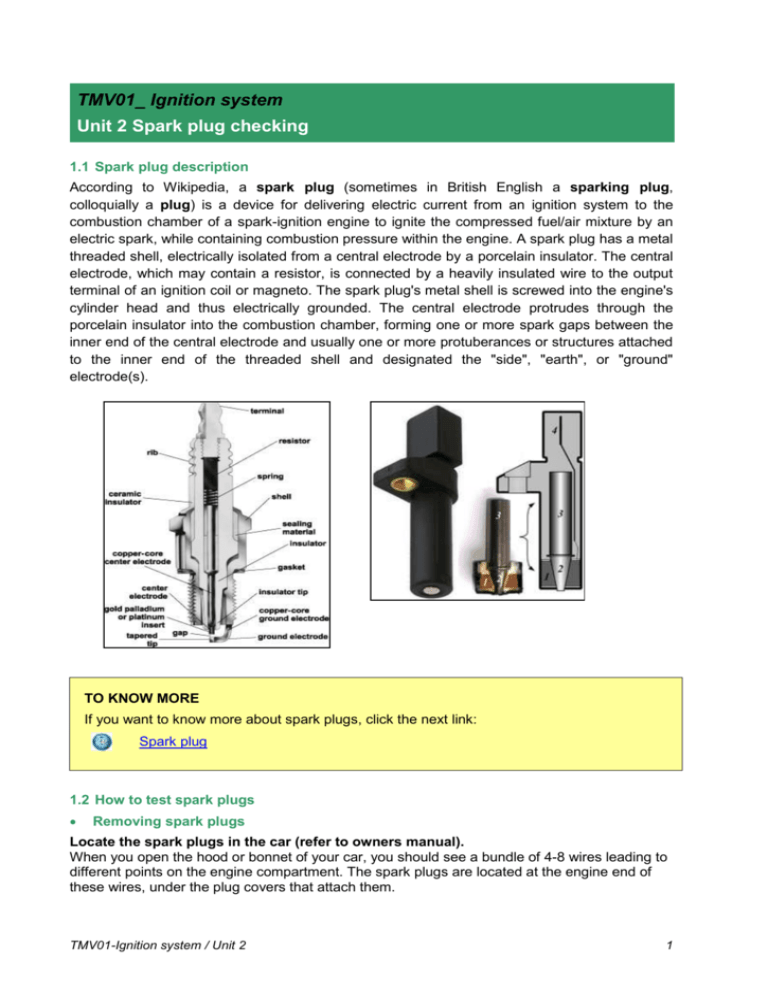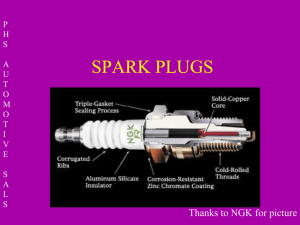Módulo: Mecanizado (MEC)
advertisement

TMV01_ Ignition system Unit 2 Spark plug checking 1.1 Spark plug description According to Wikipedia, a spark plug (sometimes in British English a sparking plug, colloquially a plug) is a device for delivering electric current from an ignition system to the combustion chamber of a spark-ignition engine to ignite the compressed fuel/air mixture by an electric spark, while containing combustion pressure within the engine. A spark plug has a metal threaded shell, electrically isolated from a central electrode by a porcelain insulator. The central electrode, which may contain a resistor, is connected by a heavily insulated wire to the output terminal of an ignition coil or magneto. The spark plug's metal shell is screwed into the engine's cylinder head and thus electrically grounded. The central electrode protrudes through the porcelain insulator into the combustion chamber, forming one or more spark gaps between the inner end of the central electrode and usually one or more protuberances or structures attached to the inner end of the threaded shell and designated the "side", "earth", or "ground" electrode(s). TO KNOW MORE If you want to know more about spark plugs, click the next link: Spark plug 1.2 How to test spark plugs Removing spark plugs Locate the spark plugs in the car (refer to owners manual). When you open the hood or bonnet of your car, you should see a bundle of 4-8 wires leading to different points on the engine compartment. The spark plugs are located at the engine end of these wires, under the plug covers that attach them. TMV01-Ignition system / Unit 2 1 On a 4-cylinder engine, spark plugs will be located on the top or side of the engine in a row. On an inline 6-cylinder, located on the top or side of the engine head, on V6 and V8-cylinder engines, plugs should be separated evenly on each side of the engine. Some cars have engine covers and you'll have to remove to see the spark plug wires, tracing them back to find the plugs themselves. You should always check the owner's manual and look up where your spark plugs are, how many you have, the correct "gap" and the size socket needed to remove them. You should also number the corresponding leads to the cylinder so as not to confuse which lead goes where when replacing with new plugs. The engines with DIS coil-over-plug systems don’t have spark plug wires. In this case you’ll find the spark plugs under each individual ignition coil. Let the engine cool before removing your spark plugs. If you've been running the car for a while, the plugs and the entire engine and exhaust system manifold can get extremely hot. Only remove them when the engine is cool enough to touch. In the mean time, assemble your tools while you wait for your engine to cool. To change your spark plugs, you'll need: A ratchet socket drive wrench An extension bar Spark plug socket, usually included in most ratchet socket sets A spark gap gauge or feeler gauge Remove the first spark plug. Pull the wire plug from the engine by gripping it as closely to the bottom as possible and working it gently and carefully off to reveal the spark plug. Don't yank on the wire to pull out of the plug. Fit your socket wrench with the extension bar and use the ratchet to remove the spark plug from its housing slowly and with caution. When checking to see if the plugs need replacing, simply remove one spark plug and check the gap. If contacts are burnt out, refit the plug and lead to the correct torque setting then go to the auto parts store and get new plugs before removing any more. You will need to remove the plugs one at a time, keeping track of the order. (Tip: Remember to number each lead with a felt tipped marker pen or on a piece of masking tape and a pen.) Spark plugs fire in a specific order, and crossing a wire to the wrong plug will make the engine run rough or not at all and can cause damage to your engine. TMV01-Ignition system / Unit 2 2 Remember: If you need to remove all the plugs at once for some reason, consider using small pieces of masking tape to mark each wire with a numbered location by pen, so you can replace them easily and correctly. Measure the gap of the spark plug. This number should be a specific measurement anywhere between 0.7 and 1.5 mm with a bit of wiggle room depending on your particular set of plugs and your car. These days, most plugs come preset according to the model number of the plug and their application but, it is wise to double check. Refer to the owner's manual to find out the optimum distance for spark plug gap and use a gap checker or feeler gauge to check the distance. If the distance of the spark plug gap is higher than it should be, but the plug is still of a relatively high quality and is an adjustable-gap plug, you can either try and change the gap by gently tapping the plug on a wooden surface with the gauge in between the plug gap until the desired measure is set at the correct measurement, or you can simply buy new plugs. It's usually recommended replacing the plugs after every 20,000 Km or as indicated in your vehicle owners manual. spark TMV01-Ignition system / Unit 2 3 A fine gap checker could be very useful. It's basically a metal ring you can use to see if the electrodes are close enough to fire properly. Feeler gauges are even more precise and give a wider range of applications. Check the existing plugs for wear. It is normal for the spark plug to appear somewhat dirty even if the plug is working properly, but you will need to change your spark plugs if you see any white, limey build up around the electrodes of the plugs, or if you see any evidence of burning or parts of the electrode missing. Heavy sooty build-up also suggests that you need to change your plugs. HIGHLIGHTS If the plugs are bent, black, or broken, the engine can have a mechanical problem. Check the engine! HIGHLIGHTS If a spark plug isn’t right and must be replaced, then consider replacing all the spark plugs. TMV01-Ignition system / Unit 2 4 Consider cleaning around the threads before reinserting the new spark plugs. When you're changing your plugs, it's also a good opportunity to check the wires to wear and to clean up around the wire terminal. Use a wire brush or compressed air to clean up around the wire connections and make sure you've got a good, clean port. Replace the wires if necessary. Consider lubricating the plugs prior to installing them. Try to put a very small amount of anti-seize lubricant on the plug threads if you are installing them in an aluminium engine. The anti-seize prevents a reaction between dissimilar metals. You can also use a small amount of dielectric silicone compound on the inside of the spark plug wire boot to make the plugs easier to remove in the future. always turn the plug backwards on the thread until you located the hole correctly so as not to cross thread your new plug to avoid damaging the head and plugs. Insert the new plugs and tighten them. At the beginning, tighten a bit by hand. Then, use the ratchet and adjust the tightening torque at the right value. Remember to replace the spark-plug cables on the same plugs they originally came from, and remove the masking tape once done. HIGHLIGHTS Never over tighten the plugs as you can easily strip the thread on the head of the engine and repairs are costly and time consuming. 1.3 Results Fill in the form with the results and measurements of the tests Spark plug 1 Spark plug 2 Spark plug 3 Spark plug 4 Visual inspection Gap (mm) TMV01-Ignition system / Unit 2 5 All the images are from http://www.wikihow.com/. This website is under the Creative Commons license. TMV01-Ignition system / Unit 2 6





